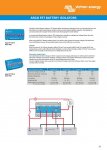slag
Chief Petty Officer
- Joined
- Jul 17, 2009
- Messages
- 471
I'm looking at blue sea battery switches. I currently have a single battery and don't want to be stranded at the lake due to a bad battery or running it down. I want to have both batteries charge while underway, and have one battery stay full while one is used for the accessory port and radio and everything else. I thought I wanted a blue sea 9002e switch with AFD, but that will require constant manipulation of the switch and I read this blurb on a blog:
"The problem is that this requires a lot of thought by the operator, who is trying to relax in the first place. Inevitably, the operator (or the operator’s Brother in Law) may leave the switch in the BOTH position, resulting in a very dead battery. Statistically, dead batteries are one of the most common reasons for calling a towing service. “I can’t crank my engine!” is right up there with “I’m out of gas!” for ruining a day on the water."
If I loan my boat out to a relative or my wife takes friends out, I don't want to have her worry about remembering which switch does what. So then I read up that this one would be better for me, the 5511e, but don't understand why it is better.
"A simpler alternative to isolate your Start and House circuits is available in the Dual Circuit Plus Battery Switch (5511e). In the ON position, it keeps your batteries isolated, so both can’t be fully discharged by accident. In the COMBINE position, it parallels your batteries in the event of a low Starting battery. Used with the 7610 Automatic Charging Relay (ACR), it automatically combines or isolates your batteries when in the ON position."
How can it "automatically" combine or isolate the batteries? Does that mean I would need to run separate wiring from the blower/acc port, stereo, etc back to just one battery instead of using my existing wiring? Sounds like a headache to me.
Here's what I want. I want to charge both batteries, but keep one isolated from the other without having to do anything more than simple wiring up of different terminals at the battery end and not constantly manually switching back and forth between batteries. If this is not possible, it sounds like the first option would be the best and easiest to implement. Also, it needs to be cheap. I already have two batteries, just need input on what switch to buy to do this with minimal effort from others who might use the boat.
I already have two batteries, just need input on what switch to buy to do this with minimal effort from others who might use the boat.
"The problem is that this requires a lot of thought by the operator, who is trying to relax in the first place. Inevitably, the operator (or the operator’s Brother in Law) may leave the switch in the BOTH position, resulting in a very dead battery. Statistically, dead batteries are one of the most common reasons for calling a towing service. “I can’t crank my engine!” is right up there with “I’m out of gas!” for ruining a day on the water."
If I loan my boat out to a relative or my wife takes friends out, I don't want to have her worry about remembering which switch does what. So then I read up that this one would be better for me, the 5511e, but don't understand why it is better.
"A simpler alternative to isolate your Start and House circuits is available in the Dual Circuit Plus Battery Switch (5511e). In the ON position, it keeps your batteries isolated, so both can’t be fully discharged by accident. In the COMBINE position, it parallels your batteries in the event of a low Starting battery. Used with the 7610 Automatic Charging Relay (ACR), it automatically combines or isolates your batteries when in the ON position."
How can it "automatically" combine or isolate the batteries? Does that mean I would need to run separate wiring from the blower/acc port, stereo, etc back to just one battery instead of using my existing wiring? Sounds like a headache to me.
Here's what I want. I want to charge both batteries, but keep one isolated from the other without having to do anything more than simple wiring up of different terminals at the battery end and not constantly manually switching back and forth between batteries. If this is not possible, it sounds like the first option would be the best and easiest to implement. Also, it needs to be cheap.




















